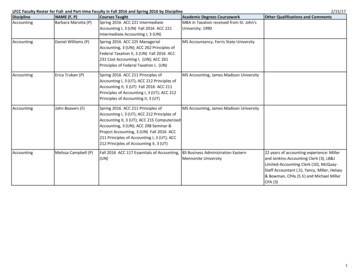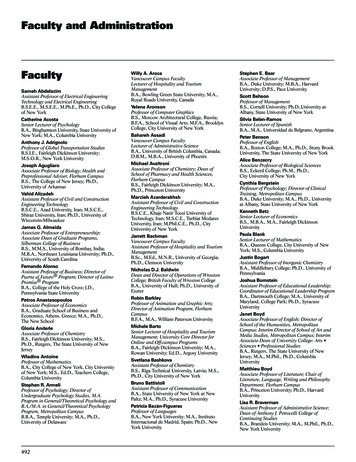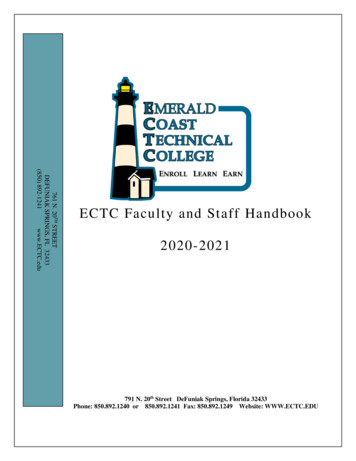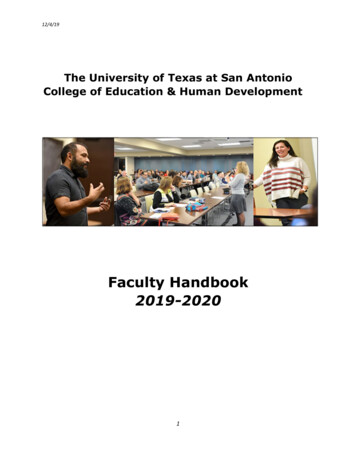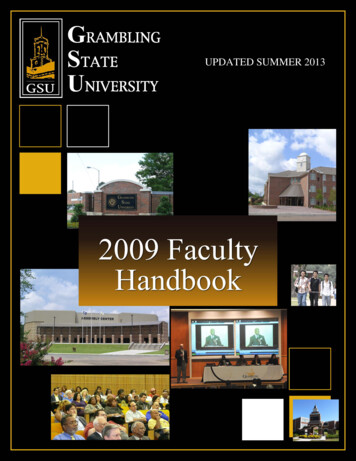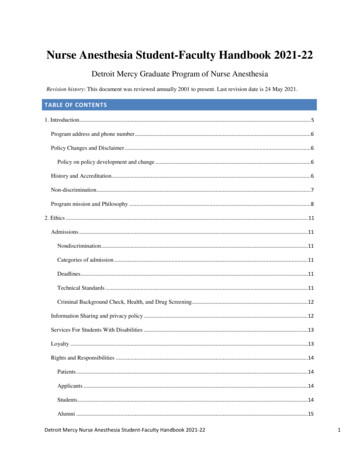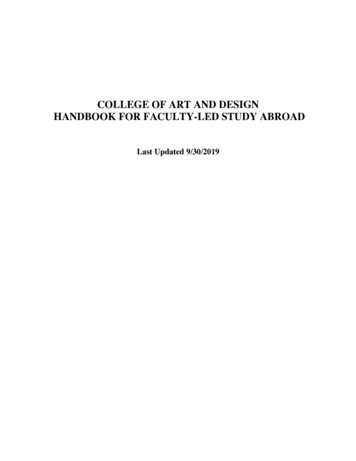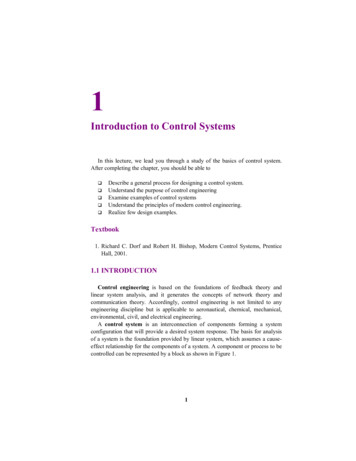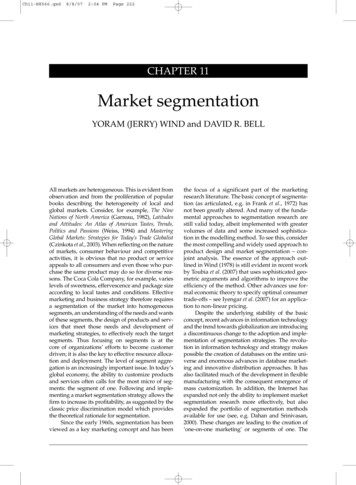
Transcription
1FACULTYHANDBOOKVersion 4.0February, 2012Kaplan University 2012Faculty HandbookUpdated February, 2012
2Table of ContentsTable of Contents 1.0KAPLAN UNIVERSITY OVERVIEW AND CULTURE 1.1History of Kaplan University - Commitment to Excellence 1.2Mission Statement .1.3University Purposes .1.4Accreditation .1.5Academic Governance .1.6University Structure 1.7Academic Programs Offered at Kaplan University .1.8University Calendar 2.0UNIVERSITY FACULTY 2.1Faculty Qualifications .2.1.1 Graduate Qualifications 2.1.2 Undergraduate Qualifications .2.1.3 Exceptional Qualifications 2.2Faculty Role and Teaching Load 2.2.1 Overloads and Adjunct Faculty Limits 2.2.2 Non-teaching Periods (NTPs) .2.3Faculty Responsibilities .2.4Cancelled Courses & Rescheduling Stipends 2.5Professional Development 2.5.1 Faculty Training .2.5.2 Scholarship .2.5.3 Individual Development Plan 2.5.4 Center for Teaching & Learning 2.6Faculty Evaluation 2.6.1 Full-time Faculty .2.6.2 Adjunct Faculty 2.6.3 End-of-Term Surveys .2.7Classroom Standards .2.8Service to the Institution .2.9Academic Rank .2.9.1 Appointment and Initial Rank 2.9.2 Changes in Rank .2.9.3 Policy Exceptions 2.9.4 Limitations of Rank .3.0FACULTY RIGHTS AND RESPONSIBILITIES .3.1Academic Freedom .3.2Academic Responsibility and Professional Ethics .3.3Intellectual Property .Kaplan University 2012Faculty HandbookUpdated February, 1919191920202122
33.43.53.6Use of Equipment and Software Faculty Relationship to Students .Other Academic Policies and Regulations .3.6.1 Student Plagiarism Policy .3.6.2 Plagiarism Reporting Procedures 3.7Fairness at the University .3.7.1 Americans with Disabilities Act 3.7.2 Problem Resolution Procedure: Faculty Grievances or ComplaintsRelated to Academic Matters 4.0IN SUPPORT OF TEACHING 4.1The Kaplan University Online Platform 4.2Assessment .4.2.1 Assessment of Student Learning 4.2.2 The Office of Institutional Effectiveness .Appendix A: The 60-Minute Rule for Kaplan Higher Education .Appendix B: Kaplan University Academic Appeals Policy Appendix C: Employee Plagiarism Policy Kaplan University 2012Faculty HandbookUpdated February, 201222232323252626262828282829313233
41.0KAPLAN UNIVERSITY OVERVIEW1.1History of Kaplan UniversityKaplan University, formerly Kaplan College, Quest College, and American Institute of Commerce(AIC), was founded in 1937. AIC was purchased by Quest Education Corporation in November1998 and in April of 2000 changed its name to Quest College. Quest Education Corporation waspurchased in July 2000 by Kaplan, Inc. In November 2000, the name of the College was changedto Kaplan College. In 2004, Kaplan University expanded its academic offerings to includemaster’s level programs and became Kaplan University.Throughout its history, the highest priority of the University has been to provide students with ahigh level of instruction so they would be well prepared for professional careers. Excellence inteaching, whether in traditional classrooms, online or blended delivery formats, is the goal ofthe Kaplan University faculty. Teaching is the primary responsibility of the faculty. Facultydevelopment and evaluation systems are in place to help faculty members constantly improvetheir knowledge of and skill in teaching. This handbook provides important information and is aguide to the policies and systems that support the scholarship of teaching at Kaplan University.1.2Mission StatementKaplan University is an institution of higher learning dedicated to providing innovativeundergraduate, graduate, and continuing professional education. Our programs foster studentlearning with opportunities to launch, enhance, or change careers in a diverse global society.The University is committed to general education, a student-centered service and supportapproach, and applied scholarship in a practical environment.1.3University PurposesTo accomplish its mission, Kaplan University has established the following purposes:1. Provide academic programs that have been developed and assessed by faculty, staff,and members of the educational, professional, and business communities.2. Provide intensive and comprehensive instruction, using both onsite and online modes ofdelivery that strengthens student academic achievement.3. Instill in its students the value of lifelong learning by stimulating intellectual curiosity,creative and critical thinking, and awareness of culture and diversity.4. Plan and provide facilities and resources that respond to the needs of students, faculty,and staff.5. Assist students in developing professional attitudes, values, skills, and strategies thatwill enhance their potential for success in their careers and in life.6. Prepare students to meet the ever-changing needs of their communities now and in thefuture.Kaplan University 2012Faculty HandbookUpdated February, 2012
51.4AccreditationKaplan University is accredited by The Higher Learning Commission of the North CentralAssociation of Colleges and Schools (NCA).1.5Academic GovernanceAs delineated in the KU Academic Governance Manual, located e/govadmin/default.aspx, the academicorganization of Kaplan University consists of the provost, the presidents and deans of theconstituent schools, vice presidents, vice provosts, deans, assistant/associate deans,department chairs, and faculty.The head of the academic organization is the provost, who reports to the president. Theacademic deans report to the provost for the general management of academic affairs relatingto the University. Campus deans report to campus presidents. The academic deans of ConcordLaw School report to the president and dean of Concord Law School.The faculty constitutes the highest academic authority of the University. The faculty has fullauthority in all areas of academic integrity, quality, and excellence of the University within thelimits defined by the University Board of Trustees. The Board of Trustees is responsible forapproving the educational degree programs of the University and for adding or discontinuingdegree programs. Determination of course offerings and curriculum is the responsibility of thefaculty.Faculty status and duties related to University service will be voluntary and by invitation fromthe provost.Faculty authority of constituent schools shall reside with the faculty members of thoseconstituent schools. Faculty members whose institutions operate under specific statutory andregulatory authority are expected to conform their practices and procedures to those statutesand regulations, even when inconsistent with this manual.1.6University StructureKaplan University offers education programs online and onsite, and offers graduate andundergraduate programs. Details about degree offerings are found in the University Catalog andon the KU Campus website at https://kucampus.kaplan.edu1.7Academic Programs Offered at Kaplan UniversityKaplan University offers graduate, undergraduate, associate, and diploma programs. Pleaserefer to the University Catalog for details, located on the KU Campus website athttps://kucampus.kaplan.eduKaplan University 2012Faculty HandbookUpdated February, 2012
61.8University CalendarThe university calendar is located on the KU Campus website at https://kucampus.kaplan.eduKaplan University 2012Faculty HandbookUpdated February, 2012
72.0UNIVERSITY FACULTY2.1Faculty QualificationsFaculty status and duties will be voluntary and by invitation from the dean of each school. Allfaculty members must have earned their academic credential(s) from accredited institutions.2.1.1Graduate QualificationsTo be considered academically qualified to teach graduate-level courses at the 500-level orabove, a faculty member must: (a) have a terminal degree in the assigned area of teachingresponsibilities; (b) have a terminal degree outside of the assigned area of teachingresponsibilities, but with sufficient professional development that incorporates the assignedarea of teaching responsibilities; or (c) have a terminal degree and a minimum of 18 semestercredit hours (27 quarter credit hours) of graduate work in the area of assigned teachingresponsibility.To be considered professionally qualified to teach graduate-level courses at the 500-level orabove, a faculty member must have a master's degree in the field combined with a record ofextensive professional experience and other appropriate professional certifications. Faculty inthis category must be approved by the Provost.2.1.2Undergraduate QualificationsTo be considered academically qualified to teach undergraduate courses, a faculty membermust: (a) hold a master’s degree, (b) have significant professional experience in the assignedarea of teaching, and (c) have substantial documented teaching experience. If the master’sdegree is not in the field, the faculty member must have a minimum of 18 semester credit hours(27 quarter credit hours) of graduate work in the area of assigned teaching responsibility.To be considered professionally qualified to teach undergraduate courses, a faculty membermust hold a bachelor’s degree in the field combined with a record of extensive professionalexperience and other appropriate professional certifications. Faculty in this category must beapproved by the Provost.2.1.3Exceptional QualificationsIn some instances, individuals who do not meet the above qualifications may be granted facultystatus by the Provost, upon recommendation by the dean, if the individual has exceptionalqualifications based on experience and demonstrated performance in the field.2.2Faculty Role and Teaching LoadA faculty member may have the opportunity to participate in academic decision-making bodiessuch as academic committees, as appropriate; vote for, or be a member of, the UniversitySenate, in accordance with his or her eligibility; and be accorded other rights and responsibilitiesas a member of the Kaplan University Faculty. The teaching loads for faculty members may beKaplan University 2012Faculty HandbookUpdated February, 2012
8adjusted up or down upon the discretion of the dean. Full-time faculty members will not beexpected to teach more than five classes in any one quarter.Online: Kaplan University Faculty shall include Kaplan University employees who typically teach14 courses per year as full-time undergraduate faculty or 12 courses per year as full-timegraduate faculty. Adjunct faculty members are temporary part-time employees who receive aLetter of Engagement (LOE) and term-to-term course assignments. The normal load for adjunctfaculty is one or two courses per term.Onsite: Kaplan University Faculty shall include Kaplan University employees who typically teach17-19 courses per year as full-time undergraduate faculty. Adjunct faculty members aretemporary part-time employees who receive a Letter of Engagement (LOE) and term-to-termcourse assignments. The normal load for adjunct faculty is one or two courses per term.Adjunct faculty members who sign a Letter of Engagement (LOE) are viewed as temporaryemployees and there should be no expectation that a Letter of Engagement (LOE) will be issuedfor every term.Full-time and adjunct faculty members generally report to Chairs and Deans, whosefundamental responsibilities include ensuring the effective functioning of the University and thecontinued fulfillment of its mission.Full-time and adjunct faculty members are expected to perform services for the institution aspart of their position. This can include, but is not limited to, mentoring, leading courses, leadingnew student orientations, leading new faculty training. Only activities that require the sameamount of time as teaching a course, such as developing a course, should result in a reduction ofthe course load. Both undergraduate and graduate full-time faculty may be eligible for up to atwo (2) course load reduction based upon a dean-approved research agenda. For informationabout approved non-teaching periods see 2.2.2. All faculty members are expected to continuetheir professional development as guided by their schools or campuses.2.2.1 Overloads and Adjunct Faculty LimitsFull-time faculty and full-time employees are limited to two overload courses per year unlessexpressly approved by the designated Vice President or Campus academic administrator.Normally, full-time faculty members do not teach at other institutions. If faculty members doteach part-time at another institution they need to notify their immediate supervisors annuallyand conform to the Conflict of Interest policy published in the Employee loyeeHandbook.aspx2.2.2 Non-teaching PeriodsNon-teaching periods (NTPs) are periods of longer than five (5) days where a full-time (FT)faculty member is not engaged in instructional activity connected to the KU academic calendar.A NTP may occur when either:Kaplan University 2012Faculty HandbookUpdated February, 2012
9(a) A faculty member switches tracks or returns from an approved absence and mustwait for his/her next teaching term to begin, or(b) A faculty member, with the approval of the Academic Department Chair, AssistantDean of Faculty, Associate Dean (if applicable), and Dean, takes a full academic term toengage in scholarship and/or service on a full-time basis. Unless approved by Dean,faculty may not take more than one (1) pre-planned NTP during any twelve (12) monthperiod.Timing of the proposed NTP will be taken into account and must similarly be approved by theaforementioned leadership.Approval for an NTP does not alter the faculty member’s normal teaching load. Classes thatwould normally be taught during the NTP must therefore be shifted to other terms in theacademic calendar, with the approval of the aforementioned leadership.When any NTP is proposed, the faculty member must submit a clear, detailed NTP plan, forapproval by the aforementioned leadership. In situation (a) above, the NTP plan must besubmitted one term in advance, and in situation (b), at least two terms in advance of theproposed NTP.In order to guide faculty in the creation of their NTP Plan, the following guidelines should beused: NTP Plans must include a clear, measurable delineation of how faculty will spendeach week of the NTP. Because faculty are year-round, full-time employees, theservice and scholarship activities described in the NTP Plan must always total atleast forty hours each week.Faculty should be as precise as possible in identifying the scope, duration, andtargeted outcomes for all activities described in the NTP Plan.NTP Plans that include scholarship activities lasting more than three (3) weeksshould include a clear deliverable to be produced at the conclusion of the NTP. Forexample, if an NTP includes four weeks of full-time engagement in writing a journalarticle to be submitted to a journal, the faculty member must submit this article tothe aforementioned administrators, as well as to the editors of the journal specifiedin his/her NTP Plan.Activities described in the NTP Plan should be in line with Kaplan University goalsand mission, as well as the goals and mission of the department and school wherethe faculty member is employed.If not taking Personal Time Off (PTO), faculty are expected to be fully available by e-mail, instantmessage, and telephone, as indicated by the leadership of the school. Faculty will be expectedto attend all required meetings and will satisfy all normal school/department commitmentsduring the NTP, just as they would during any academic term. Unless otherwise specified byschool leadership, the Academic Department Chair will oversee NTPs and will meet regularlywith faculty to discuss progress against the NTP Plan. If, at any stage, school leadershipKaplan University 2012Faculty HandbookUpdated February, 2012
10determines that a faculty member is not meeting his/her NTP commitments, the facultymember will be placed back on the instructional calendar as soon as leadership can do so.2.3Faculty ResponsibilitiesThe focus of the faculty role is on teaching, professional development, and service to theUniversity. Some of the responsibilities incorporated into this role include, but are not limitedto:A. General Providing a learning environment that supports student success. Maintaining program and course outcomes along with course content at a level toensure appropriate workplace skill levels for graduates. Maintaining and submitting accurate and timely reports for student grades. Reporting concerns regarding student academic progress to the appropriate person. Referring students with questions regarding financial aid, academics, attendance,and personal issues or concerns to the appropriate departments. Actively assisting the University in retention and/or outreach efforts which includetelephoning students who are not engaged in the course or absent per departmentor campus guidelines. Participating in institutional assessment activities as assigned. Regularly attending and participating in faculty meetings and continuousimprovement sessions. Completing and reporting no fewer than 8 hours of formal/active professionaldevelopment activities each year. Note that the requirement for faculty teaching inthe Schools of Business and Management and Information Systems and Technologyis no fewer than 15 hours of formal/active professional development activities. Serving on University committees as assigned. Assisting Chairs and Deans in developing and implementing new programs asassigned. Remaining current with trends, techniques, and advances in technology that areapplicable to the program. Maintaining open communication with students and the University. Providing students with appropriate guidance regarding academic excellence andattendance. Completing other duties as assigned by the Chairs or Deans. Incorporating creative instructional strategies and/or learning activities. Providing meaningful and substantive instruction throughout the course. Reporting student behavioral and Code of Conduct issues.B. Class Schedules, Absences, EmergenciesThe University will establish the schedule and assignments for each class and facultymember (with input from faculty members regarding vacations and other commitments inKaplan University 2012Faculty HandbookUpdated February, 2012
11appropriate cases). Once established, th
Kaplan University offers education programs online and onsite, and offers graduate and undergraduate programs. Details about degree offerings are found in the University Catalog and on the KU Campus website at https://kucampus.kaplan.edu . 1.7 Academ
